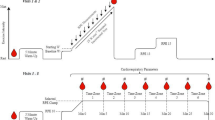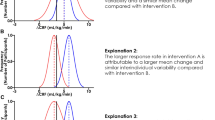Abstract
Published reports have shown large apparent inter-individual differences of gains in maximal oxygen intake (V̇O2max) in response to a standard 20-week programme of aerobic conditioning that progressed to 75% of the individual’s initial V̇O2max. The observed gains of V̇O2max ranged from 0 to 1,000 ml min−1, with a coefficient of variation (CV) of 8.4%. The present analysis evaluates the potential contribution of test–retest errors to these apparent large inter-individual differences in training response. The 2-day test–retest CV for V̇O2max readings in 742 healthy adults was initially 5.0%, dropping to 4.1% after training. Published training responses were estimated from the mean of paired measurements obtained before and after training if readings agreed by <5%, but from the highest of paired values if these differed by >5%. Taking account of the relative proportions of single and paired observations, the weighted V̇O2max data for the entire sample had an effective 2-day CV of 4.3% before and 3.4% after training. Assumption 1: if the 20-week test–retest error remained similar to the 2-day figure, measurement error would contribute a CV of 5.5% to apparent training responses, or (for the stated initial mean V̇O2max of 2,409 ml min−1) an SD of 132 ml min−1. Assumption 2: if the 20-week CV was similar to that in other long-term studies (~5%), measurement error would contribute a CV of 6.1%, or a SD of 146 ml min−1. The published data show a total SD of 202 ml min−1 for apparent inter-individual differences in training response, with age, gender, race and baseline V̇O2max accounting for only 11% of this variance. After estimating the likely effect of test–retest measurement errors, the SD due to inter-individual differences would decrease to 138 ml minV̇O2max (assumption 1) or 123 ml min−1 (assumption 2). We conclude that when estimating the extent of inter-individual differences in training response, allowance must be made not only for the minor effects of recognized covariates (age, gender, race and initial fitness), but also for the larger influence of test-retest measurement errors. Nevertheless, substantial inter-individual differences persist after making such adjustments. The most likely explanation of these differences is a familial aggregation of training responses.



Similar content being viewed by others
References
Bouchard C, Rankinen T (2001) Individual differences in response to regular physical activity. Med Sci Sports Exerc 33: S446–S451
Bouchard C, An P, Rice T, Skinner JS, Wilmore JH, Gagnon J, Pérusse L, Leon AS, Rao DC (1999) Familial aggregation of V̇O2max response to exercise training: results from the HERITAGE Family Study. J Appl Physiol 87:1003–1009
Carter J, Jeukendrup AE (2002) Validity and reliability of three commercially available breath-by-breath respiratory systems. Eur J Appl Physiol 86:435–441
Hamel P, Simoneau JA, Lortie G, Boulay MR, Bouchard C (1986) Heredity and muscle adaptation to endurance training. Med Sci Sports Exerc 18:690–696
Jensen K, Jorgensen S, Johansen L (2002) A metabolic cart for measurement of oxygen uptake during human exercise using inspiratory flow rate. Eur J Appl Physiol 87:202–206
Jones NL, Kane M (1979) Inter-laboratory standardization of methodology. Med Sci Sports Exerc 11:368–372
Prud’homme D, Bouchard C, LeBlanc C, Landry F, Fontaine E (1984) Sensitivity of maximal aerobic power to training is genotype dependent. Med Sci Sports Exerc 16:489–493
Shephard RJ (1994) Aerobic fitness and health. Human Kinetics, Champaign, Ill.
Shephard RJ, Rankinen T, Bouchard C (2003) How much does the error of measurement contribute to the apparent heterogeneity of training response? (abstract). Med Sci Sports Exerc 35:S192
Simoneau JA, Lortie G, Boulay MR, Marcotte M, Thibault MC, Bouchard C (1986) Inheritance of human skeletal muscle and anaerobic capacity adaptation to high intensity intermittent training. Int J Sports Med 7:167–171
Skinner JS, Wilmore KH, Jaskola A, Jaskolski A, Daw EW, Rice T, Gagnon J, Leon AS, Wilmore JH, Rao DC, Bouchard C (1999) Reproducibility of maximal exercise test data in the HERITAGE Family Study. Med Sci Sports Exerc 31:1623–1628
Taylor HL, Buskirk ER, Henschel A (1955) Maximal oxygen intake as an objective measure of the cardiorespiratory performance. J Appl Physiol 8:73–80
Wright GR, Sidney K, Shephard RJ (1978) Variance of direct and indirect measurements of aerobic power. J Sports Med Phys Fitness 18:33–42
Wyndham CH, Strydom NB, Maritz JS, Morrison JF, Peter J, Potgieter ZU (1959) Maximum oxygen intake and maximum heart rate during strenuous work. J Appl Physiol 14:927–936
Author information
Authors and Affiliations
Corresponding author
Rights and permissions
About this article
Cite this article
Shephard, R.J., Rankinen, T. & Bouchard, C. Test–retest errors and the apparent heterogeneity of training response. Eur J Appl Physiol 91, 199–203 (2004). https://doi.org/10.1007/s00421-003-0990-4
Accepted:
Published:
Issue Date:
DOI: https://doi.org/10.1007/s00421-003-0990-4




